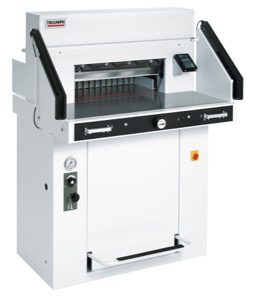Whether in the classroom, the office or the studio, every workspace needs a paper cutter. Scissors just can’t compete with the clean, perfectly straight cut of a quality paper cutter. These tools come in two flavors, and it’s important to know the advantages of each before making a purchase.
Marie Antoinette Was NOT a Fan
You don’t have to be a French Revolutionary to enjoy a good guillotine cut. The guillotine cutter has one long blade arm that is pulled down to make a cut through stacks of paper. These are great if you’re cutting stacks of newsletters, invitations, postcards, placecards, pamphlets, reply devices, or handouts. Because these use heavy-duty blades, they are also typically a heavier unit for stability. They’re often equipped with a tabletop measurement guide clearly marked, and typical cuts are outlined on the surface. One of our models will cut up to 360 sheets of 20# paper in a single stroke.
Make a Precision Slice
If you need to make a precise cut, but you’re not worried about cutting stacks of paper, then a rotary cutter is your best bet. Artists and model builders use these, as well as scrapbookers, photographers, and teachers. The rolling wheel blade is sharp, safe and glides easily over your project on a sliding rail. What you don’t want is the cheaper knock-off version of a rotary cutter. These use a razor-like blade that dulls quickly and works poorly on anything but standard stock paper. Forget cutting photos, artist quality paper, or cardstock.
Most rotary cutter models come with a measurement guide on the surface and the side, plus an adjustable depth guide to help you align your project with precision. You’ll set the transparent clamping bar to hold your trimming material in place and allow you to monitor the trimming process. Then, twin sliding poles will guide your blade with comfort and accuracy. It’s pretty quick and always precise.
Check out Lloyd’s selection of paper cutters and see which one is for you.

